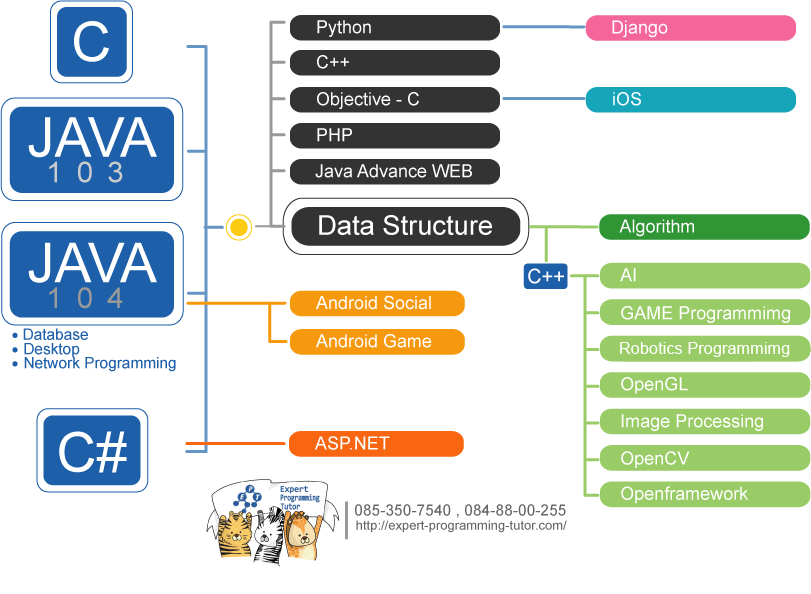ในยุคปัจจุบันนี้ การพัฒนาแอปพลิเคชันต่าง ๆ จำเป็นต้องใช้ฐานข้อมูลในการจัดเก็บข้อมูลอย่างมีประสิทธิภาพ โดยเฉพาะอย่างยิ่งในการพัฒนาแอปพลิเคชันที่มีการจัดการข้อมูลจำนวนมาก ซึ่ง NoSQL เป็นตัวเลือกที่ได้รับความนิยมอย่างมากในวงการโปรแกรมมิ่ง เพื่อนำเสนอโซลูชันที่ยืดหยุ่นและมีการเติบโตที่ดี ในบทความนี้เราจะมาเรียนรู้เกี่ยวกับการสร้าง Code NoSQL CRUD (Create, Read, Update, Delete) โดยใช้ภาษา C กันค่ะ
NoSQL (Not Only SQL) คือ ฐานข้อมูลที่ไม่ใช้รูปแบบตารางเหมือนฐานข้อมูล SQL มีความแตกต่างในลักษณะการจัดเก็บข้อมูล ซึ่งสามารถจัดเก็บข้อมูลในรูปแบบต่าง ๆ ไม่ว่าจะเป็น Document, Key-Value, Column Family หรือ Graph โดยมีความสามารถในการยืดหยุ่น Scalability และ Performance ที่ดีกว่าฐานข้อมูลเชิงสัมพันธ์ในบางกรณี
มาลองสร้างโปรเจคตัวอย่างที่สามารถทำ CRUD กับฐานข้อมูล NoSQL โดยใช้ MongoDB ซึ่งเป็นหนึ่งในฐานข้อมูลที่นิยมที่สุดในสาย NoSQL และใช้ภาษา C เพื่อเขียน Code CRUD แค่ง่ายๆ
ขั้นตอนที่ 1: ติดตั้ง MongoDB C Driver
ก่อนที่เราจะเริ่มเขียนโค้ดได้ เราต้องติดตั้ง MongoDB C Driver เสียก่อน เราสามารถเลือกใช้ Package Manager ของ Linux หรือ Windows ในการติดตั้งได้ตามขั้นตอนข้างล่าง
1. เปิด Terminal หรือ Command Prompt
2. ใช้คำสั่งการติดตั้ง
```sh
sudo apt-get install libmongoc-dev
```
3. จากนั้นให้ตรวจสอบว่าเราสามารถเรียกใช้ Driver ได้
ขั้นตอนที่ 2: การเชื่อมต่อกับ MongoDB
เราจะต้องสร้างฟังก์ชันเพื่อเชื่อมต่อกับฐานข้อมูล MongoDB และทำการเลือก Database ที่เราต้องการ ตัวอย่างโค้ดเชื่อมต่อกับ MongoDB มีดังนี้:
ฟังก์ชันนี้จะช่วยให้เราเชื่อมต่อกับ MongoDB ได้ที่ `localhost` ที่ Port 27017 และเลือกใช้ Database และ Collection ที่เราต้องการ
ขั้นตอนที่ 3: การสร้างข้อมูล (Create)
เราจะใช้ฟังก์ชันสำหรับการสร้างข้อมูลเข้าไปใน Collection ของ MongoDB โดยจะใช้ `bson` เพื่อสร้าง Document ใหม่ สำหรับการสร้างข้อมูลสามารถทำได้ดังนี้:
ขั้นตอนที่ 4: การอ่านข้อมูล (Read)
การอ่านข้อมูลจาก Collection สามารถทำได้ด้วยการใช้ Cursor เพื่อวนไปอ่าน Document ที่ถูกจัดเก็บอยู่:
ขั้นตอนที่ 5: การอัพเดตข้อมูล (Update)
สำหรับการอัพเดตข้อมูลใน MongoDB ก็ทำได้ง่ายเช่นกัน โดยเราจะใช้ฟังก์ชันนี้ในการค้นหา Document และอัพเดตค่าต่าง ๆ ที่เราต้องการ:
ขั้นตอนที่ 6: การลบข้อมูล (Delete)
สุดท้ายการลบข้อมูลก็สามารถทำได้ดังนี้:
สรุปและขั้นตอนต่อไป
ในบทความนี้ เราได้เรียนรู้การทำ CRUD ในฐานข้อมูล NoSQL ด้วยการใช้ MongoDB และเขียนโค้ดด้วยภาษา C ตั้งแต่การเชื่อมต่อ การสร้างข้อมูล การอ่านข้อมูล การอัพเดตข้อมูล และการลบข้อมูล ซึ่งเพียงทำตามตัวอย่างง่าย ๆ ก็สามารถนำไปต่อยอดเพื่อใช้งานจริงได้
หากคุณต้องการเรียนรู้เพิ่มเติมเกี่ยวกับการพัฒนาโปรแกรมใน NoSQL และภาษา C ที่มีประสิทธิภาพมากขึ้น อย่าลืมพิจารณาศึกษาเรียนที่ EPT (Expert-Programming-Tutor) ที่เป็นสถาบันการศึกษาที่มีเป้าหมายเพื่อสร้างโปรแกรมเมอร์ใหม่ในแบบฉบับของคุณ และมอบความรู้ที่สำคัญเพื่อให้คุณสามารถก้าวเข้าสู่วงการเทคโนโลยีได้อย่างมั่นใจ!
อ้างอิง
- Documentation ของ MongoDB: [MongoDB Official Docs](https://docs.mongodb.com/)
- MongoDB C Driver: [MongoDB C Driver Documentation](https://mongoc.org/libmongoc/current/installing.html)
หวังว่าบทความนี้จะช่วยให้คุณเข้าใจการทำงานกับ NoSQL Database และ อย่างง่ายในภาษา C ได้ดียิ่งขึ้น หากมีคำถามยินดีต้อนรับให้ติดต่อสอบถามได้ที่ EPT ค่ะ!
หมายเหตุ: ข้อมูลในบทความนี้อาจจะผิด โปรดตรวจสอบความถูกต้องของบทความอีกครั้งหนึ่ง บทความนี้ไม่สามารถนำไปใช้อ้างอิงใด ๆ ได้ ทาง EPT ไม่ขอยืนยันความถูกต้อง และไม่ขอรับผิดชอบต่อความเสียหายใดที่เกิดจากบทความชุดนี้ทั้งทางทรัพย์สิน ร่างกาย หรือจิตใจของผู้อ่านและผู้เกี่ยวข้อง
Tag ที่น่าสนใจ: java c# vb.net python c c++ machine_learning web database oop cloud aws ios android
หากมีข้อผิดพลาด/ต้องการพูดคุยเพิ่มเติมเกี่ยวกับบทความนี้ กรุณาแจ้งที่ http://m.me/Expert.Programming.Tutor
085-350-7540 (DTAC)
084-88-00-255 (AIS)
026-111-618
หรือทาง EMAIL: NTPRINTF@GMAIL.COM
